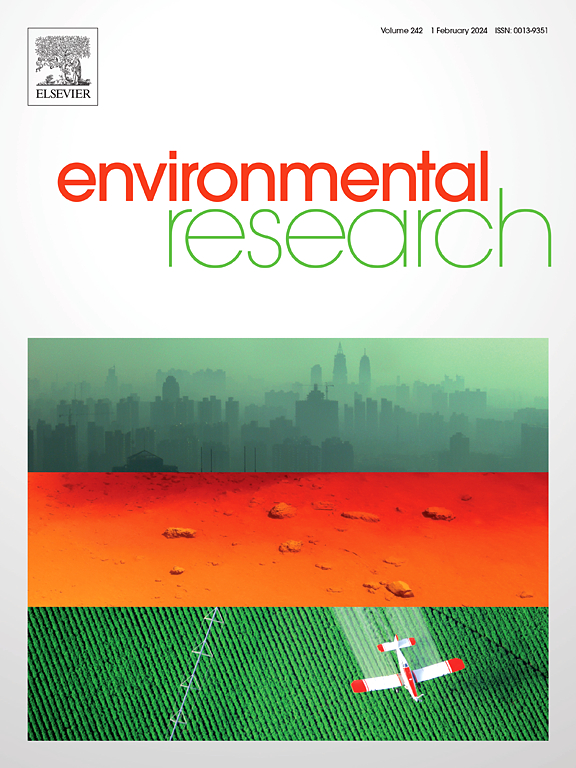揭示了Al2O3对厌氧污泥中硫转化的影响
IF 7.7
2区 环境科学与生态学
Q1 ENVIRONMENTAL SCIENCES
引用次数: 0
摘要
Al2O3 是一种多功能吸附剂和脱水剂,被广泛认为是一种实用且环保的添加剂,可提高发酵效率,促进从废弃活性污泥(WAS)中回收资源。然而,它对 WAS 发酵的潜在有害影响,如生成硫化氢(H2S),却一直被忽视。本研究发现,随着 Al2O3 用量从 0 增加到 60 mg/g VSS,H2S 的最大产生量从 371.60 ± 3.72 × 10-4 降至 303.36 ± 3.03 × 10-4 mg/g VSS。对含硫化合物转化的研究发现,降低硫化氢(H2S)形成的主要原因是氧化铝(Al2O3)对硫酸盐还原的抑制作用。机理分析发现,Al2O3 最初会刺激污泥 EPS 中的官能团和氢键网络。这导致 C-C 基团的含量增加了 2.04%,C-O-C 基团的含量增加了 7.78%,β-turn 和 α-Helix 结构的含量增加了 4.24%。这导致污泥 EPS 断裂,并释放出铝、镁和铁等可溶性金属离子。释放出的金属离子促进了 H2S 气体和溶解硫化物向金属硫化物的转化,从而大大减少了 H2S 气体的排放。微生物群落研究显示,Al2O3 的加入提高了甲烷菌(如 Methanothrix)的性能,但抑制了硫酸盐还原菌(如未分类的__c__Deltaproteobacteria)。对功能基因的进一步研究表明,Al2O3 会减少参与有机硫水解(如 MetQ、epD、CDO1、yhdR 等)和硫酸盐还原过程(sat、cysC、aprAB、dsrAB 等)的功能基因数量。这些发现为使用 Al2O3 处理污泥提供了新的视角,并可能对污泥处理产生重大影响。本文章由计算机程序翻译,如有差异,请以英文原文为准。
Revealing the effect of Al2O3 on sulfur transformation in anaerobic sludge process
Al2O3, one multifunctional adsorbent and dehydrator, was widely recognized as a practical and environmentally friendly additive that enhances fermentation efficiency and facilitates the recovery of resources from waste-activated sludge (WAS). However, its potential harmful effects on WAS fermentation, such as the generation of hydrogen sulfide (H2S), have been previously overlooked. This study found that with the increase of Al2O3 dosage from 0 to 60 mg/g VSS, the maximum production of H2S decreased from 371.60 ± 3.72 × 10−4 to 303.36 ± 3.03 × 10−4 mg/g VSS. The study on the transformation of sulfur-containing compounds has identified that the primary cause for lowering the formation of hydrogen sulfide (H2S) is the inhibitory effect of aluminium oxide (Al2O3) on sulfate reduction. The mechanism analysis discovered that Al2O3 initially stimulated the functional groups and hydrogen bonding networks present in sludge EPS. This resulted in a 2.04 % rise in the content of C-C groups, a 7.78 % increase in the content of C-O-C groups, and a 4.24 % increase in the content of β-turn and α-Helix structures. This resulted in the fracturing of sludge EPS and the release of soluble metal ions such as aluminium, magnesium, and iron. The liberated metal ions facilitated the conversion of H2S gas and dissolved sulfide into metal sulfide, hence contributing significantly to the reduction of H2S gas emissions. Microbial community research revealed that the inclusion of Al2O3 enhanced the performance of methanogens (e.g., Methanothrix), but inhibited sulfate reducing bacteria (e.g., unclassified_c__Deltaproteobacteria). Additional examination of functional genes demonstrated that Al2O3 decreases the amount of functional genes involved in the hydrolysis of organic sulfur (such as MetQ, pepD, CDO1, yhdR, etc.). and sulfate reduction processes (sat, cysC, aprAB, dsrAB, etc.). These findings offer novel perspectives on the treatment of sludge using Al2O3 and could have substantial consequences for sludge treatment.
求助全文
通过发布文献求助,成功后即可免费获取论文全文。
去求助
来源期刊

Environmental Research
环境科学-公共卫生、环境卫生与职业卫生
CiteScore
12.60
自引率
8.40%
发文量
2480
审稿时长
4.7 months
期刊介绍:
The Environmental Research journal presents a broad range of interdisciplinary research, focused on addressing worldwide environmental concerns and featuring innovative findings. Our publication strives to explore relevant anthropogenic issues across various environmental sectors, showcasing practical applications in real-life settings.
 求助内容:
求助内容: 应助结果提醒方式:
应助结果提醒方式:


